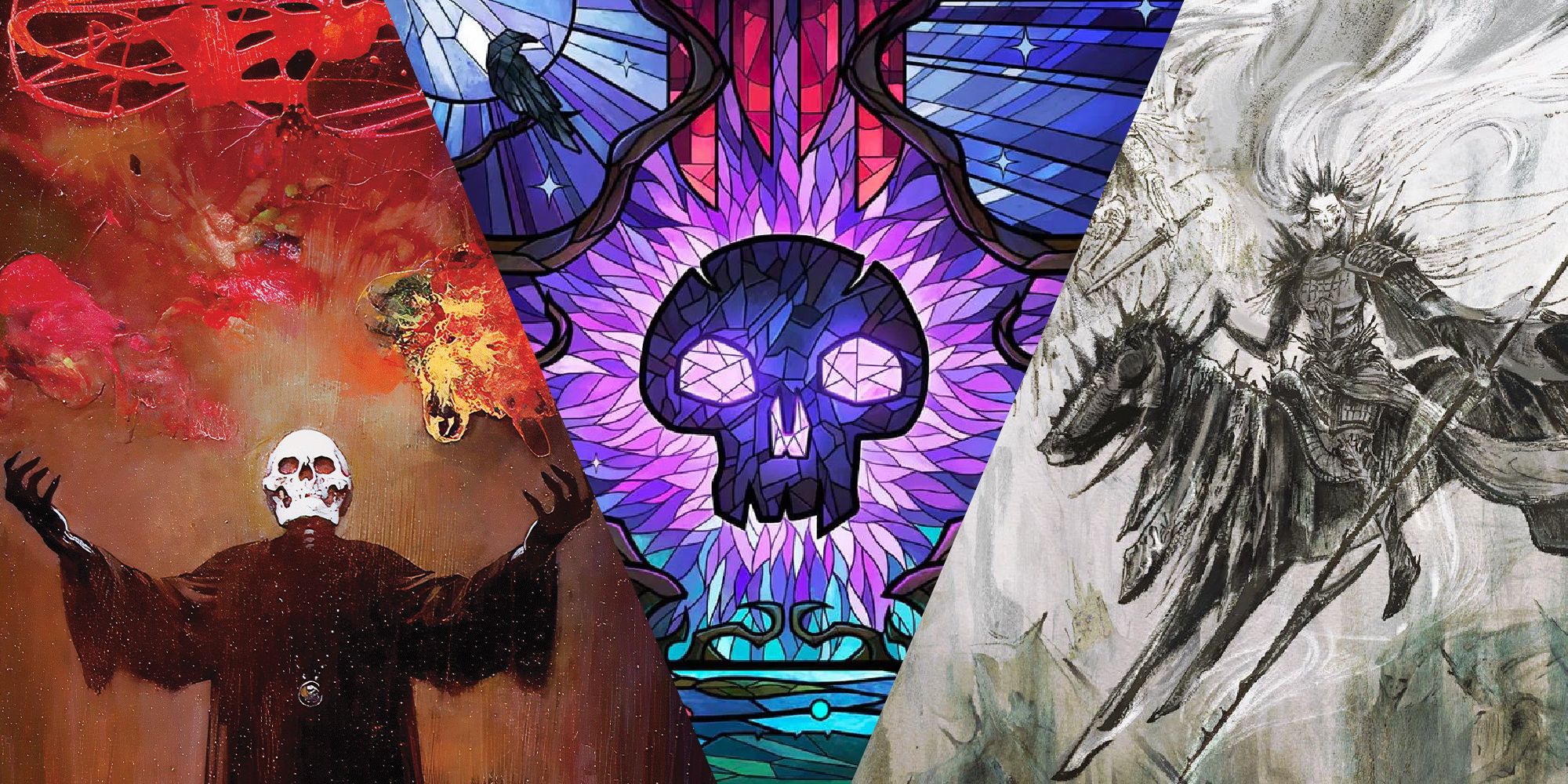Magic: The Gathering – Mono-Black Commander Staples Guide

Quick Links
- Removal
- Board Wipes
- Drawing Cards
- Recursion
- Ramp
Mono-black decks have a long and strong history in Magic: The Gathering, a tradition passed into Commander, which has become a home for both jank and spells too powerful to be printed into formats like Modern or Pioneer. These cards are supplemented nicely by the increasing power levels of new designs, especially when it comes to commanders themselves.
Related:Magic: The Gathering - How To Use Scryfall
More than any other color, mono-black has staples that can fit in just about any black-using deck, regardless of its game-plan or construction. Don't overlook these cards without good and specific reason, such as wanting to maintain a lower power level, building on a budget, or sticking to a particular theme.
Removal
While black might not have the most versatile removal in Magic: The Gathering, notably struggling with countering spells and destroying artifacts, it contains the largest selection of cheap creature removal. While the cards all have unique drawbacks or restrictions, the staples among them will almost never be dead cards.
Card Name
Reason for Inclusion
Feed the Swarm
One of black's extraordinarily rare cards that can remove an enchantment of your choice, Feed the Swarm is cheap, with a downside that matters less when you have 40 life to start the game.
Deadly Rollick
The value of exiling a creature instead of destroying it, combined with Deadly Rollick's likelihood to be cast for free, all at instant speed, make it an easy inclusion.
Infernal Grasp
Unconditional creature removal at instant speed for only two mana is a great deal, and the value brought far outweighs the minor loss of life.
Ravenous Chupacabra
The drawbacks of Ravenous Chupacabra, a mana value of four and sorcery speed, are somewhat negated when you consider how it interacts with cards that return it to the battlefield, such as Kaya's Ghostform or Reanimate.
Go for the Throat
Despite certain artifact creatures undeniably being large threats, they still make up the minority of most decks you'll be facing, and Go for the Throat is otherwise as valuable as Infernal Grasp.
Murderous Rider
Murderous Rider's capacity to destroy planeswalkers in addition to creatures is useful, and being able to cast it as a creature with decent power and toughness afterwards can come in handy.
Related: Magic: The Gathering – The Best Board Wipes For Commander
Board Wipes
In Commander, it is essential that each card you play gives you an advantage, or disadvantages an opponent. Board wipes usually put every player in the game at a disadvantage, which might seem bad. However, the disadvantage you're creating for yourself is almost always less than the total amount of disadvantage you're causing to your opponents, especially in black where you have ample graveyard recursion at your disposal.
Black has a plethora of options for board wipes that remove creatures, and many of them have unique advantages not found in other colors. For example, black board wipes might lower the power and toughness of every creature, and when a creature's toughness becomes zero it dies even if it has indestructible.
Card Name
Reason for Inclusion
Damnation
Damnation is black's color-shifted counterpart to the first board wipe ever printed, Wrath of God, and both still hold up to this day as efficient creature sweepers.
Toxic Deluge
Toxic Deluge has everything you could want from a board wipe: It gets around indestructibility, it only costs three mana, and you have a limited ability to choose what creatures to kill in this manner by paying less for its additional cost.
The Meathook Massacre
Despite The Meathook Massacre potentially costing a lot of mana to do its job as a proper board wipe, its secondary benefits give the card enough flexibility to make it a staple.
Massacre Girl
Five mana might seem steep for a conditional board wipe, but Massacre Girl's ability can be triggered again later using the same means as Ravenous Chupacabra. In addition, she provides a 4/4 creature body with menace, and will almost always end up as the last one standing.
Black Sun's Zenith
The key difference between Black Sun's Zenith and the other board wipes here is that it places counters on the creatures instead of temporarily giving them -1/-1, meaning you can situationally cancel out +1/+1 counters with it, or just power down the entire battlefield if you don't have the mana to make it a real wrath.
Mutilate
Easily at its strongest in mono-black decks, Mutilate will often rid the board of all but the toughest creatures.
Drawing Cards
Usually the downside to drawing cards in black is the death of one of your creatures, or more frequently, a small loss of life. Exploiting Commander's increased starting life total of 40 to gain a massive amount of card advantage over your opponents is par for the course in mono-black decks.
Card Name
Reason for Inclusion
Phyrexian Arena
An extra card on each of your turns is well worth the single point of life that you lose, and Phyrexian Arena quickly becomes an advantage that has to be answered by the other players.
Necropotence
A contender for one of the strongest black cards ever printed, Necropotence leaps from great to unparalleled when you have so much more life to work with when compared to a one-on-one format.
Dark Confidant
The lowest mana value card draw staple also punishes you the hardest as a result. Playing a Dark Confidant is like playing with fire: You can do a lot of damage with it, but you might get burned.
Greed
Ironically, the most budget-friendly option for repeatable card draw is Greed. Unlike the other staples of its kind, Greed requires you to pay mana and life, making it harder to exploit.
Ad Nauseam
Found frequently at the center of cEDH decks, Ad Nauseam is treated as a win condition more than it is a card draw engine since the hyper-competitive top decks will almost always achieve victory after it resolves.
Related: Magic: The Gathering – Best Black Commanders For cEDH
Tutors
Black has no shortage of tutors – or cards that let you search your deck for specific cards – being the color to have the original Demonic Tutor, giving the category of card the name "tutor" in the first place.
Tutors themselves break a fundamental rule of most card games, which is that you're at the mercy of the cards you draw. Black's tutors allow you to ignore this by searching for any card you like, completely unrestricted, and placing it directly into your hand, or on top of your library.
Card Name
Reason For Inclusion
Demonic Tutor
Magic: The Gathering's first ever tutor has found its permanent home as a staple in Commander, being banned, restricted, or never printed in any other official format due to its strength.
Diabolic Intent
The less-powerful brother of Demonic Tutor, Diabolic Intent still brings incredible value, especially if you have token creatures to sacrifice for its additional cost.
Diabolic Tutor
The slowest of the tutor staples, Diabolic Tutor is still a good addition to decks on a budget or in slower games, and sets the bar for the minimum capabilities of a black tutor staple.
Grim Tutor
Better than Diabolic Tutor, but nowhere near the power level achieved by other tutor staples, Grim Tutor is often overlooked when upgrading decks.
Vampiric Tutor
Although Vampiric Tutor only puts the card on top of your library, due to the ability to cast it as an instant, you can play the spell on the end step directly before your turn to draw the card right away.
Imperial Seal
Unlike Vampiric Tutor, Imperial Seal has to be cast as a sorcery, which means that you're at a much higher risk of someone disrupting you drawing the card that you search for. However, only one mana and two life is worth the risk, especially since black has few issues drawing cards at instant speed.
Entomb
Despite not actually placing the card you searched for into your hand or on top of your library, Entomb enables very powerful graveyard strategies that are present in almost every black deck.
Buried Alive
Three Entombs in a trench coat make a card that can reach a higher ceiling at the cost of being a bit clumsy. The additional mana cost makes it harder to use the entombed cards the same turn they've been tutored for.
Recursion
Bringing cards from your graveyard back into your hand or, better yet, onto the battlefield, is key to many strategies in Magic: The Gathering. Even if your deck's game plan does not revolve around such tactics, the value these spells bring to most decks gives you options, especially as the game goes on.
Card Name
Reason For Inclusion
Reanimate
Comboing nicely with cards such as the aforementioned Entomb, Reanimate offers a cheap way cheat a creature's mana cost by first placing it into your graveyard and then spending life instead of mana to cast it. Barring that, it still manages to be a low-cost option of bringing a creature back to life, even from your opponent's graveyard.
Victimize
Sacrificing a low-cost creature to revive two much more valuable creatures is a nice option at only three mana.
Animate Dead
Despite its confusing updated rules text, Animate Dead's effect is rather simple and beneficial. Casting it means placing a creature from a graveyard onto the battlefield and attaching Animate Dead to it. If Animate Dead leaves the battlefield, you sacrifice the creature that had been brought back.
Malakir Rebirth
Granting pseudo-protection at instant speed, Malakir Rebirth can also be played as a land, allowing you to slot it into any deck as a replacement for a basic Swamp.
Mortuary Mire
Similar to Malakir Rebirth, Mortuary Mire being a land makes the relatively weaker benefit it grants still worth running.
Ramp
Ramp in mono-black is centered around three main pillars: Counting the amount of swamps you have, sacrificing or killing creatures, and a type of card called a "ritual" that is more commonly printed as a red effect. These rituals are one-time mana boosts named after the card Dark Ritual. Usually they involve paying a small amount of mana to make a larger amount of mana of that same color, which is useful when you want to cast a large spell (or multiple smaller ones) that same turn.
Card Name
Reason For Inclusion
Dark Ritual
Printed in the original 1993 Alpha set of Magic: The Gathering, Dark Ritual is both widely-available and widely-applicable to mono-black decks. Since you're already restricted to casting only black and colorless spells, the three black mana that Dark Ritual makes will be handy in casting any of them.
Cabal Ritual
Filling your graveyard in mono-black isn't the easiest task, but it's not exactly difficult either, and Cabal Ritual will often make you five black mana later in the game, while still maintaining some use early on if you're short a land drop.
Culling the Weak
Combining two of black's main ramp pillars, Culling the Weak does require that you sacrifice a creature, and thus has a narrower use case since you don't want to sacrifice a creature that would have cost four or more mana to cast in the first place.
Cabal Coffers
Between the iconic art and its place as a unique method of ramping, Cabal Coffers makes the most sense in mono-black decks.
Cabal Stronghold
The weaker version of Cabal Coffers, Cabal Stronghold might cost an additional mana to activate and only count basic Swamps, but it still has its place in most mono-black decks that will win the game with high-mana spells.
Crypt Ghast
In the same vein as Cabal Stronghold, Crypt Ghast is most useful in mono-black decks that want to finish by casting high-mana value cards.
Phyrexian Tower
Sacrificing a creature in black is less of a risk than some other colors due to its recursion cards, and the extra mana made is worth the tradeoff.
Revel in Riches
Both a source of ramp and a potential win-condition, Revel In Riches does rely more strongly on your opponents' creatures being destroyed than would normally be acceptable. However, since it creates treasure tokens as opposed to directly adding mana, you are more free to utilize that ramp at your own pace.
Next:Magic: The Gathering - Mono-Blue Commander Staples Guide













